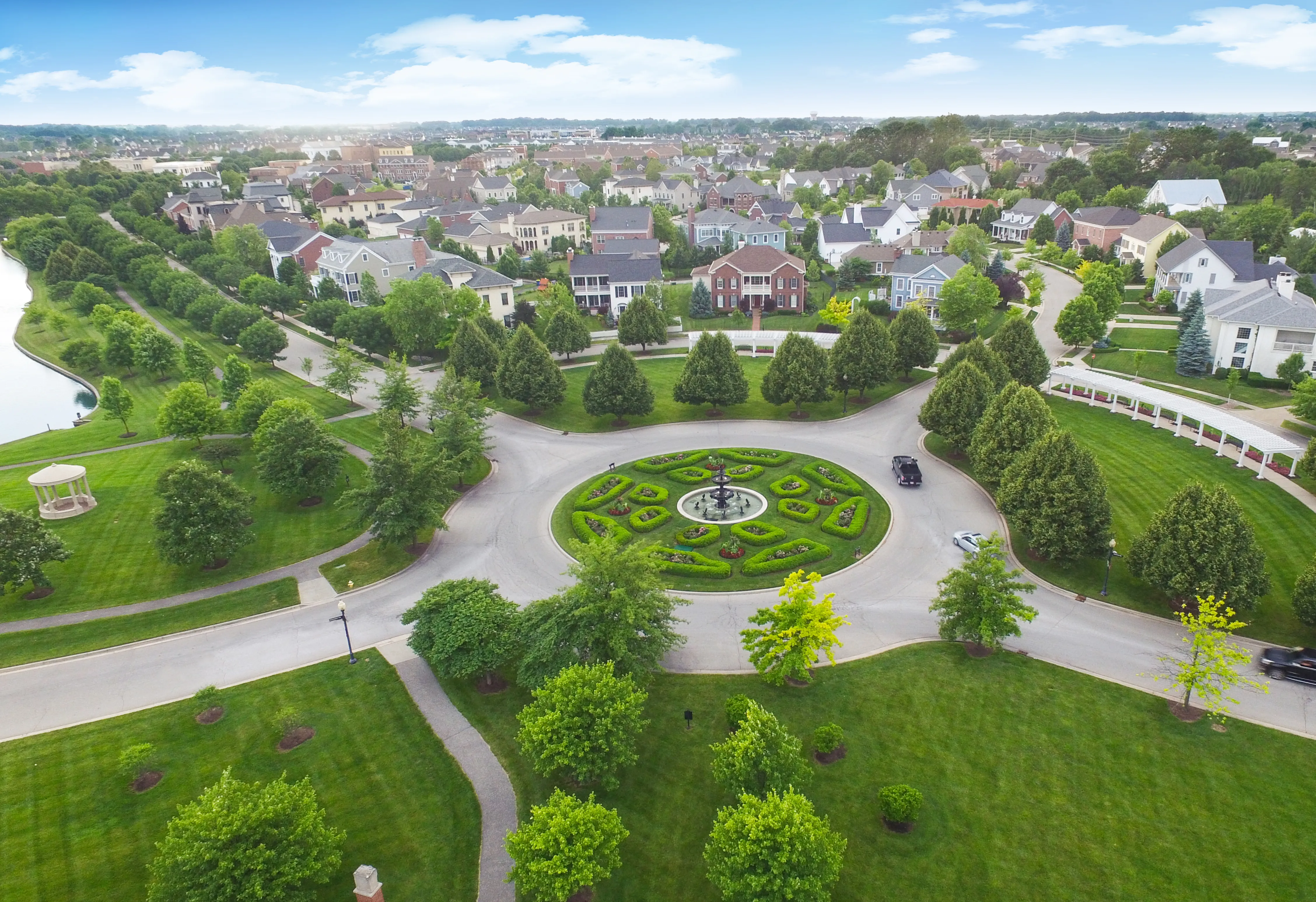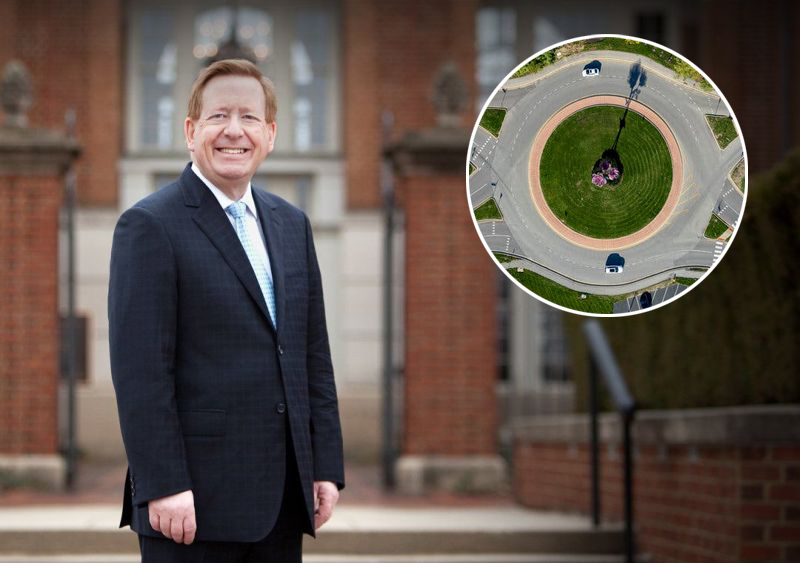This is the third a three-part series in celebration of National Roundabouts Week, which runs from Sept. 19-23. Check out the other articles in the series as they’re published here.
The Indianapolis suburb of Carmel has become internationally famous for its commitment to a hotly-debated traffic safety intervention known as the "roundabout." It wasn't always that way, though — until Mayor Jim Brainard came along.
Since first taking office in 1996, Brainard has made retrofitting the city's road network the centerpiece of his platform, ripping out hundreds of traffic lights and replacing them with roughly 140 innovative circular traffic treatments that have helped slash rates of car crash deaths and serious injuries to some of the lowest levels in the nation. But he says that super-slow cars and countless saved lives aren't the only benefits of Carmel's approach — and that roundabouts aren't the only reason the city of 100,000 has been nationally recognized.
We sat down with Mayor Brainard to learn more.
This interview has been edited for clarity and length.
Kea Wilson: Tell me a little about Carmel's roundabout program, and a little about why this intersection design is particularly suitable for suburbs like yours.
Mayor Jim Brainard: To me, it really goes back to the invention of the automobile.
If we go back in history to the end of World War Two, our cities, back then, were still basically pedestrian cities. Every house still had a coal furnace, so our cities were dirty, and they tended to be bad places for disease, because there was a lot of over-crowding, and antibiotics were not widely available yet.
At the same time, the average working person was making more money than they pretty much ever had in the history of the world. So then, you've got it where everybody was able to buy a car, and they wanted to get out of the cities and into subdivisions.
It was a nice idea, and it worked well in some ways, but we didn't really plan how those suburbs. We had thousands of years of civilization in cities, but almost no experience with cars.
So we began designing our communities for cars, not people — places you where you couldn't go anywhere unless you were in an automobile. We began mandating more single-use zoning — what planners call Euclidean zoning — and in some ways, it was their biggest success; they separated houses on one side of town and all the factories on the other side of town, and people got healthier. They helped increase the average lifespan by 15 or 20 years by doing that.
But they never thought about all the other impacts — namely, that you could no longer walk anywhere you needed to go. There used to be be places for people with different backgrounds together in common squares and parks, but that was lost. Now we all had to drive to all the stores, usually on the edge of town. These are good places to spend your life.

So what I was hearing from people when I ran for mayor in 1996 was that they wanted someplace to go to dinner and a show without having to drive to downtown Indianapolis; they wanted to be able to walk to stores, but they didn't have anywhere to do it. So I thought about that for a while; I was a history major in undergrad, and started to analyze, in historical terms, what we've been doing since the end of the war. It was really brand new — and we made a lot of mistakes.
According to some studies, the average American today spends about two hours a day in the car. That's the average — which means some people are spending more than two hours. When you have to drive seven or eight miles just to get groceries, our cities have not been planned well.
So what we did was say, "Okay, how do we take a suburb and convert it into a traditional city?"
KW: Why prioritize roundabouts over other kinds of infrastructure improvements to make road safer?
JB: I always make this joke in my speeches were I ask, "Does anybody in this crowd ever speed up to go through a yellow light?" And as people start to raise their hands, I say, "Nevermind; surely nobody in this crowd would do that." [Laughs]
The point is, everybody runs a yellow light! Even if it's a green light, you might speed up to get through it faster before it turns red. Human error rate really didn't change that much as a percentage when we change how we design intersections; the question, is that going to be high speed crash, or a low speed crash?
But everybody has to slow down in a roundabout. They see it coming, they know they have to slow down, and they get used it. You're also eliminating left hand turns, which is the most dangerous movement at an intersection. Between those two things, our fatality rate for our city is 2.25 per 100,000 residents per year on a five year trailing average. For the country on the whole, it's about twelve. In Indianapolis, they have the same drivers, the same weather, and they're at about the national average. [Editor's note: Marion County, which contains Indianapolis, had 11.4 deaths per 100,000 residents in 2019, and 11.9 in 2018.].
The difference is the roundabouts.
KW: What are some of the other benefits of roundabouts?
JB: Well, I'm sure you've heard about our emissions benefits, because that was on the front page of the New York Times not too long ago [laughs]. Drivers also save money on gas, wear and tear.
Roundabouts are also a lot cheaper to maintain over the years; especially when you're switching a four-way stop out for a roundabout, it's always going to be cheaper. A stoplight costs about $400,000, and when you think about it, you have to replace that every 20 or 25 years as it rusts and wears out; you have to pay engineers to adjust the timing because those little boxes tend to go haywire all the time; an electrical storm hits, you have to send a cop to direct traffic.
But there are subtle savings, too. So many times, somebody in my position gets a call from a member of the public saying, "y'know, there's congestion on Jones Street; you've got to do something about it. I sat through ten minutes to get through three lights." And often what they do is add a lane. But all they're really doing is creating a bigger traffic jam, paving over more paradise, and giving people more space to wait for that light to turn green.
The roundabouts move more people per hour without widening a road. In fact, we took a street that was five lanes and reduced it to three with a beautiful center median, and people just go up to the roundabout if they need to turn around. We added a bike lane, added a wider sidewalk, and we're moving eight percent more traffic than we were before the change.
KW: I know redesigning intersections isn't cheap. I've read a little bit about how Carmel funds its roundabout program, but are there any mechanisms that you think are particularly interesting, and that might be portable to cities that aren't as wealthy as yours?
JB: So we've done a lot of public-private partnerships where we do what's called tax increment financing, or TIF.
Basically, we take an increase in property tax and use it to do things like put parking underground or in garages. Oftentimes, the revenue [we get from that] can be fifty or sixty times as much on one site [with an underground garage] compared to a big-box surface parking lot, which doesn't pay any taxes. We've seen tax revenue on nine acres going from $60,000 to $3 million a year, which can pay for a lot of infrastructure. And we're doing it in an area where you already have things like fire stations, police, and your peripheral roads already in place. So not only does the revenue go up, we also have very few increasing expenses, too.
KW: A lot of people are really skeptical about the benefits of roundabouts for pedestrians and cyclists. What do you know about how they impact safety for vulnerable road users?
JB: It's counterintuitive; people have a perception that a crosswalk is safe. And it is safe — until someone makes a mistake at 30, 40 miles per hour. The chances of someone dying in that crash are way too high. A mistake made at 10, 15 even 18 miles an hour, those people are going to walk away from it. They may have some bruises, but they're going to survive.
We've had this explosion in pedestrian and cyclist deaths across the United States during the pandemic, but we're not experiencing that here. It's all about driver speed and emergency response times. Roundabouts, by their nature, give you a refuge island halfway across that you don't always get at other types of intersections.
And for bicyclists, we have a great network of bike paths and trails that's about 250 miles and it's mostly above the curb, besides eight or nine miles. I joke that the boys in spandex don't like to ride above the curb, but most families do. And in a lot of places, they have a choice when they come to the roundabout; they can ride with the cars, that's legal, because they're moving about the same speed as the cars, or they can go on the path.
KW: Aside from the net benefits to the city on the whole that we've talked about so far, how does Carmel's approach to building its roads improve your residents' day-to-day lives?
JB: Honestly, we couldn't take a roundabout out today if we wanted to, because for the most part, the vast majority of people really like the program.
I always joke that Carmel is just like Paris, France, because we don't have good weather, or the ocean, or the mountain — and Paris does just fine at building a beautiful place to live. And part of that is the roundabouts. They're a great place for public art; about ten percent of them have it, and we take care of it so it'll last forever. It enhances the property values around those intersections, which traffic idling at stoplights just doesn't do. It inspires people, and it makes their lives more interesting.
People have a choice where they spend their lives, particularly in this employment climate. We're in a fight not just for the best and brightest, but for all kinds of workers. Putting money into beautification really does change people's lives, particularly for poorer people; they don't have the means to travel the world, but they have a right to see beautiful things in their neighborhoods, and to be safe on their roads.






